HEAT; On Rhythm, Movement, and Emergency in Suspension
by Emiliano Guevara
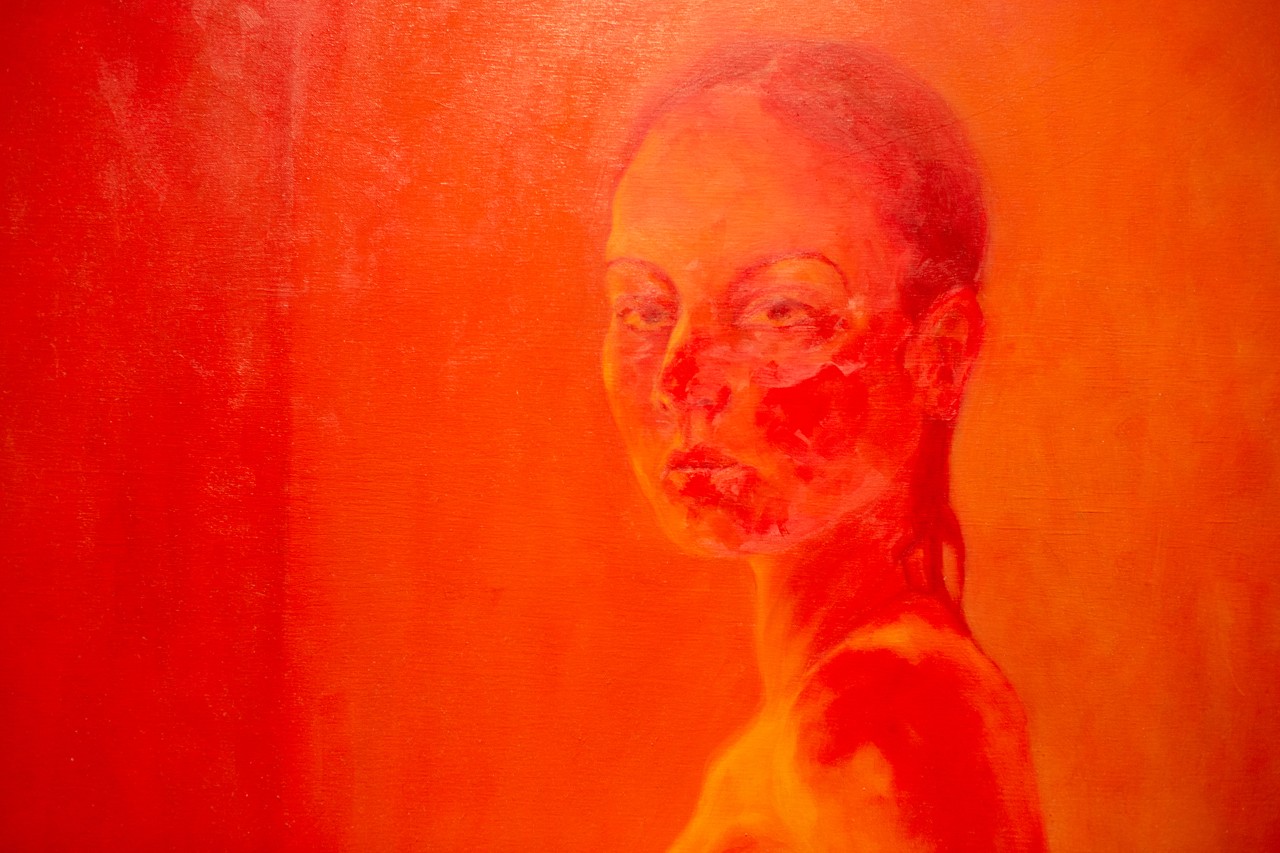 Kat Barr, (Out)Body
Kat Barr, (Out)Body
 Cassi Camille, Self-preservation, an act of political warfare
Cassi Camille, Self-preservation, an act of political warfare
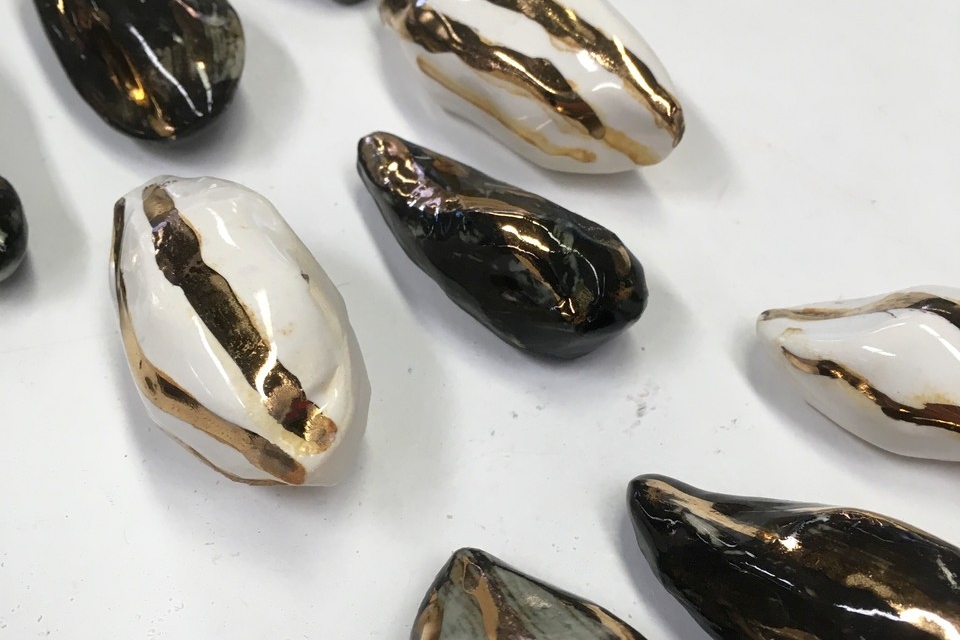 Jorge Lopera, Seeds of Hope
Jorge Lopera, Seeds of Hope
Over the stretching darkness of empty dancefloors, one can only see
Dim
Red-lit
Emergency signs.
[Enter]
It’s a bit past the last call. Having come close enough to conclusion but not to closure, heated heads and solitary dancers stroll—the wretched body of an entire species suspended; between the air and the Sun’s consummated movement.
This metaphoric scenario of clueless motions offers a faithful figuration of an eroding world and its decadent rhythm. Most artworks included in this exhibition are brought into context as radical questions on movement, transformation, and being in the contemporary condition; for which they are unwittingly alerted by our thermal urgency. Let us account for this so-called ‘contemporary condition’ as one defined by movements of fatal exhaustion, accumulative despair, and automated longing. In all of the artworks, the possibility of beyonds past this existential exhaustion remains latent. This essay is thus concerned with three artworks showcased in embodied urgencies, that are engaging critically and inviting radical reimaginings of contemporary movement.
(Out)Body (2023) by Kat Barr, is a red monochromatic painting staging a mirror game emulating the dynamics of voyeurism and bodily consumption known to museographic displays. The piece hangs in the gallery's outer vitrine, watching over the transits of St. Catherine Street. Cassi Camille’s sculpture Self-preservation, an act of political warfare (2023) poses a question with ontological implications: can movement itself be subverted? Or else, the political project to ease movement from chronological illness: to move in the otherwise—Here, Restraint and Dance, two ritual tactics invested in the altered-movement, are recalled as primordial techniques to conspire and inspire change. Picking up on similar notions of movement and transformation, Seeds of Hope (2023) by Jorge Lopera, is a ceramic work interested in reverting states of emergency to new settings of emergence. Centering attention on belief and reconciliation as forces that are directly informed by the Earth’s own generative cycles, the piece offers a refreshing reflection on the illusion of integrity, as that which lies at the loss and reunification of Body, Land, and Technique. Each of these three works offers a parallax view—and possibility behind their mirage—to the traditional systems of value production and exchange, whether they are agricultural, museographic, or choreographic animations bringing into question the power-in-movement and its alterations.
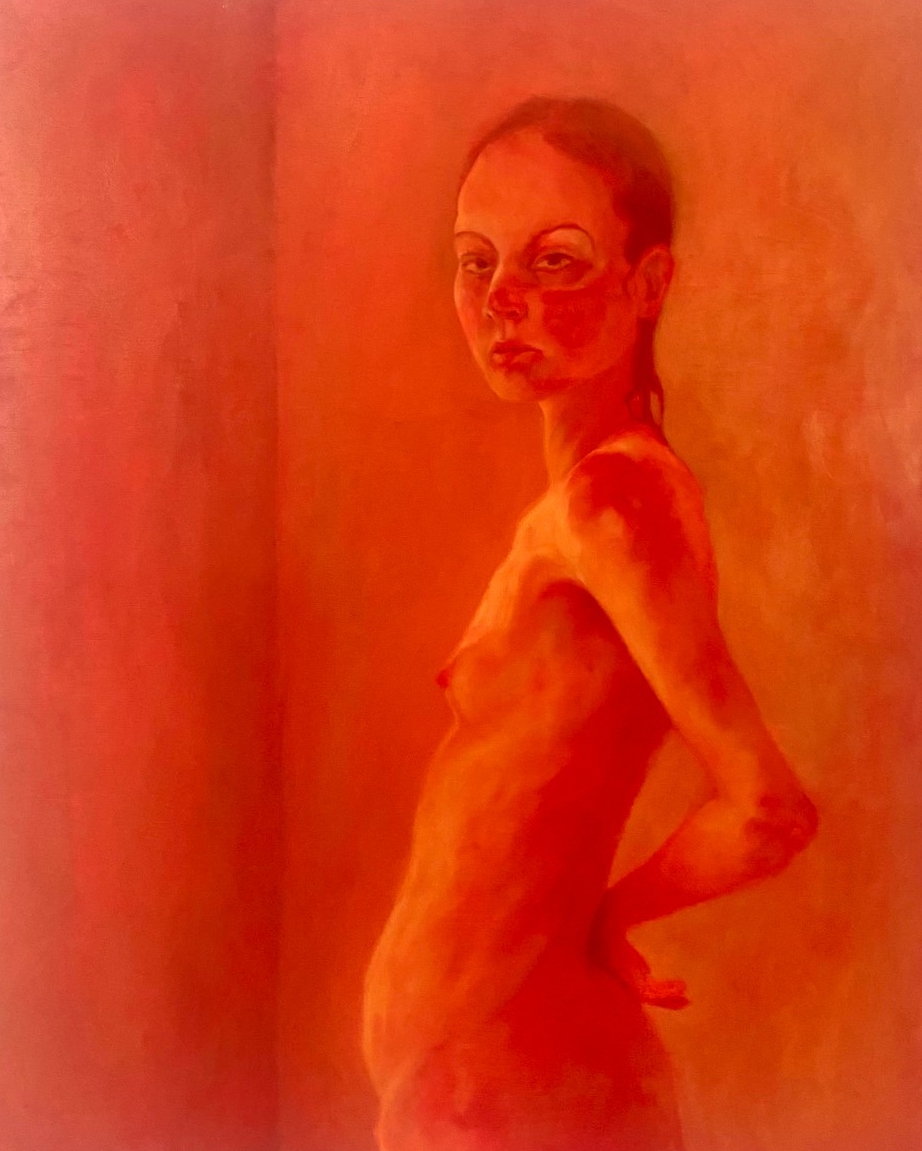 Kat Barr, 2023, oil paint on wood, 30” x 24”. Photo Credit Courtesy of the artist
Kat Barr, 2023, oil paint on wood, 30” x 24”. Photo Credit Courtesy of the artist
 Kat Barr, 2023, oil paint on wood, 30” x 24”. Photo credit: Josh Jensen
Kat Barr, 2023, oil paint on wood, 30” x 24”. Photo credit: Josh Jensen
(Out)Body
Suspension of the gaze; suspension of exchange (vision and consumption)
The piece’s title, (Out)Body, already suggests that we are dealing with some sort of corporeal outsiderness; an unaligned embodiment; a negative anatomy. The spectator is drawn into the corners of a red-saturated room alone with a naked figure who stares back at them. The diffused red radiates a painterly environment of claustral closure with the naked body placed between the spectator and a corner. Staring at each other in a heated encounter, the audience and the painting’s subject establish a looking relation of uncertain interest.
There are three kinds of perceptual animations and separations enacted by the image: suspension, reflection, and transition. For what concerns the question of heat, we must first learn about some persistent motifs in the artist’s body of work: abstract patterning, formscapes, and monochromatic diffusion. These motifs appear as figuration methods in which colour becomes environment, and form is often made distinguishable from noise resembling thermographic colouring, as if seen through the lenses of an infrared camera. Meaning, the sense of space is informed by the sense of temperature, while the sense of temperature is achieved by the infrared effect of light, which radiates over the body and space together. Finally, we shall relate these affects to the work’s external context: as part of an exhibition that deals with the economic organization of bodies-in-movement from the urgency of energetic exhaustion.
Barr’s piece directly addresses the gaze and the overarching question of body-consumption in capitalism, particularly, in the making and viewing of bodies in art as a form of commercial and spiritual exchange. This recalls the idea of the museographic gaze, as one that sets the guidelines for a perfect capitalist exchange of total unbalance: when we walk into the gallery space, we demand from the object without being expected to give something in return. Artworks like these suggest to us that the opposite might be more true. To define the sort of exchange at play in (Out)Body, it is of less use to conceive of it as a piece that gives, but rather as a piece that takes. The work demands from its viewer, with all disruptive intention, a particular kind of gesture, the violent but nonetheless reaffirming: reflection. And while it seems obvious, at first, that the spectator is set up in a vulnerabilizing relationship with the figure, the more you stare at it, and it stares back at you, the nature of that visual exchange becomes uncertain with disorienting heat. By looking at their form, we become their mirror. Our form is brought into question. For a moment, we become as fragile as them.
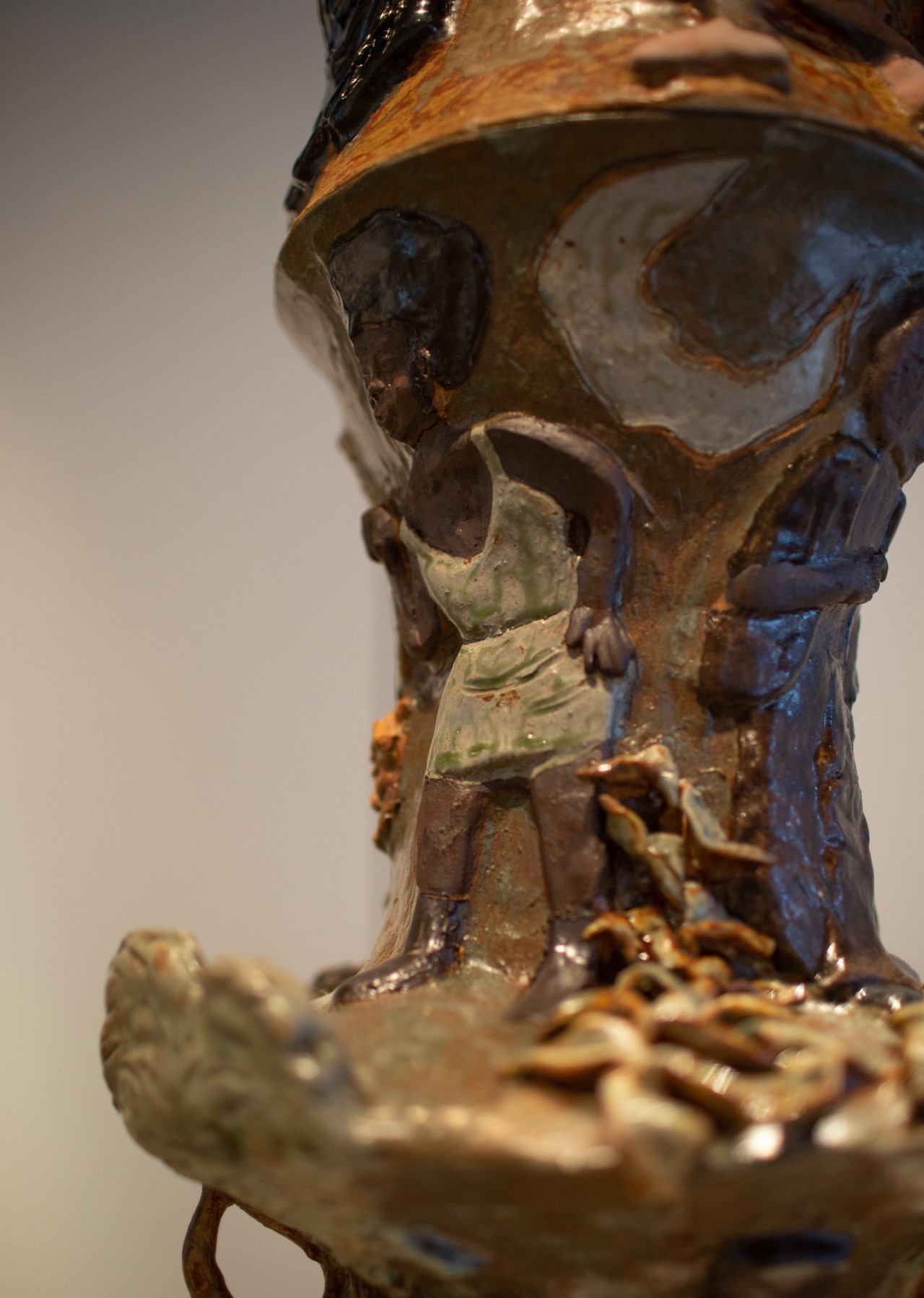 Cassi Camille, Self-preservation, an act of political warfare, 2023, Reduction-fired stoneware, ash glazes, 20" x 20" x 60" . Photo credit: Josh Jensen
Cassi Camille, Self-preservation, an act of political warfare, 2023, Reduction-fired stoneware, ash glazes, 20" x 20" x 60" . Photo credit: Josh Jensen
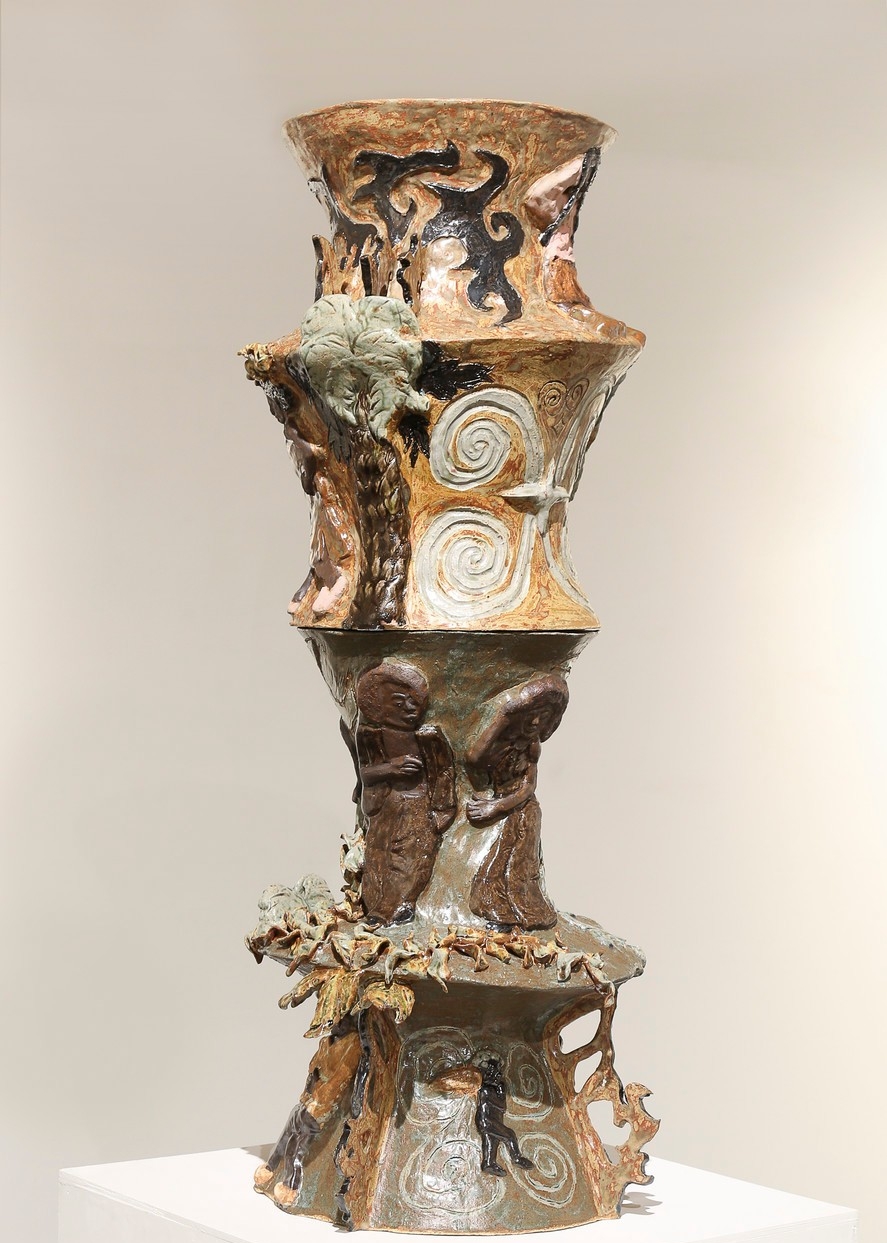 Cassi Camille, Self-preservation, an act of political warfare, 2023, Reduction-fired stoneware, ash glazes, 20" x 20" x 60" . Photo credit: Courtesy of the artist
Cassi Camille, Self-preservation, an act of political warfare, 2023, Reduction-fired stoneware, ash glazes, 20" x 20" x 60" . Photo credit: Courtesy of the artist
Self-preservation, an act of political warfare
Suspension of labour; suspension of accumulative movement, Revolution and the altered-movement.
Self-preservation, an act of political warfare by Cassi Camille, offers us an interesting philosophical detour, for it opens the question of warfare as part of the struggle to preserve oneself within the methodology of deacceleration. Materially, reduction-fired stoneware results from a process of heat-accelerated pressure and cooling-off. As a medium, ceramic embodies the notion of deacceleration at a particle level. Conceptually, Camille questions the politics of movement in the ever-accelerating motor of efficiency and production of our post-industrial condition, in which the line between our personal lives and work is blurring. When movement becomes predatory, the possibility of resting as a political gesture becomes a necessary consideration for survival.
At its most fundamental level, the function of the techniques of altered-movement is to break with the inertia of a revolutionary motion, to disturb the motion of a pre-formative order. Rest, as a modality of Restraint and in the means of self-preservation, becomes instrumental to break with the inertia of post-industrial and capitalist movement. Therein, the philosophical turn of warfare advanced by the piece first requires us to abandon the fantasy of historical revolution, and instead, reconsider Revolution as a phenomenology of recurrence, oriented perspectives, and partial appearances connecting the individual with the cosmic.
There are two powerful integrations of movement counter-tactics in the piece. One, dance (as the radical liberation from utility); two, the recurrence of continual circular movement (meta-kinetic recurrence and the impossibility of a total). In most cosmologies, particularly non-Western, cosmic movements do not resemble linear progressions and movements of accumulation, but of circuity. Here to consider the concept of Revolution as it manifests in Camille’s sculpture is not only conceptual but perceptual too: Self-preservation, an act of political warfare demands a revolutionary perspective for its appreciation. Setting the viewers in circular motion around its perimeter, the totality of its image can never be grasped, it can only be experienced fully at the zenith of a revolution.
The conceptual link between war, dance, and rest here is not to be overlooked. War is the uppermost promotion of all affects towards their own destruction (the accelerated termination of subjects, objects, and time itself); and rest, is the signifying affect of a de-animation into a sort of suspended action: restraint. In this sense, to resist is not to take a step back from movement, but to flow in reverse motion —to resist in a syncopated rhythm. Let us not forget that the act of resisting movement as a political activation is nothing new; it has been the longtime principle of striking and occupation. It is not just recent that resting becomes itself a fragmentation of time.
In a world that has been left behind by its own movement, what sort of motion inhabits hope? Toward where do we animate, and where do we rest?
 Jorge Lopera, Seeds of Hope, 2023, white earthenware, luscious black and maiolica glaze, rutile oxide and gold luster, 5” x 11” x 6”. Photo credit: Courtesy of the artist
Jorge Lopera, Seeds of Hope, 2023, white earthenware, luscious black and maiolica glaze, rutile oxide and gold luster, 5” x 11” x 6”. Photo credit: Courtesy of the artist
Seeds of Hope
Suspension of the necropolitic dawn; de-suspension of hope; balance (catharsis, resilience, redemption in soil)
Catharsis, metamorphosis, redemption, and resilience; these are words that hold no apparent material relation but become substantial propositions as they enter the semantic domain of transformation. These concepts are addressed and constantly reimagined in the work of Jorge Lopera, a multidisciplinary Colombian artist whose work can be found in the conceptual breakdown of nature and technique. Seeds of Hope (2023) is a piece that draws attention back to the soil’s generative possibility, posing a question on the possibility of revindication and emergence in the midst of omnicidal despair.
Lopera’s ceramic work resembles the shape of a cacao plant, consisting of its seeds, the exocarp, and a seed-shaped pierced leaf. It refers to a particular moment of agricultural transformation in Colombia amid the Narco and Paramilitary wars that weighed upon the territory, having brought its soil and population to a seemingly irreversible collapse. In an attempt to revert the economic and political relations that made farmers dependent on coca plantations, the Colombian government devised a plan of agricultural reintegration to incentivize the cultivation of cacao as a substantial option to replace coca plantations.
The implications of this strategy elucidate an ontological consideration: that the well-being of a population is inherently grounded in the preservation and political agency of its soil; and that only from the conscious revaluation of these relations, the political, the economic and the social can revindicate. It is from this cosmopolitical turn that we are drawn into the conceptual domain of transformation and emergence that Seeds of Hope so brilliantly imagines: here, motions of change and hope are metaphorically embodied in the form of the seed and the vessel, both images of growth and contingency.
In its materiality, Seeds of Hope presents an example of poiesis, a technical revelation that bringsforth the particular mode of being of something in a way that allows us to weave, once more, the notions of time, temperature, and rhythm. Heat as incorporation and cooling as vitrification are two modes-of-becoming elemental to this piece. Lopera explains that it is of crucial importance to mediate the cooling process with care and patience, for if the piece is brought out of the kiln too quickly, the drastic temperature change will cause it to shatter. When I asked about the intrinsic meaningfulness of this material process in the piece, he noted:“Like everything, it is all about respecting the cyclic processes, if not, there is unbalance.” i On this notion of ‘respect,’ the idea of the ‘cycle’—as in Camille’s piece—becomes primordial. First, for it conveys the point at which natural and human technical ‘cyclic processes’ become one; second, the idea of ‘respecting a cycle,’ in essence, conveys that the human mind and impulse are being challenged by an unbearable temporality.
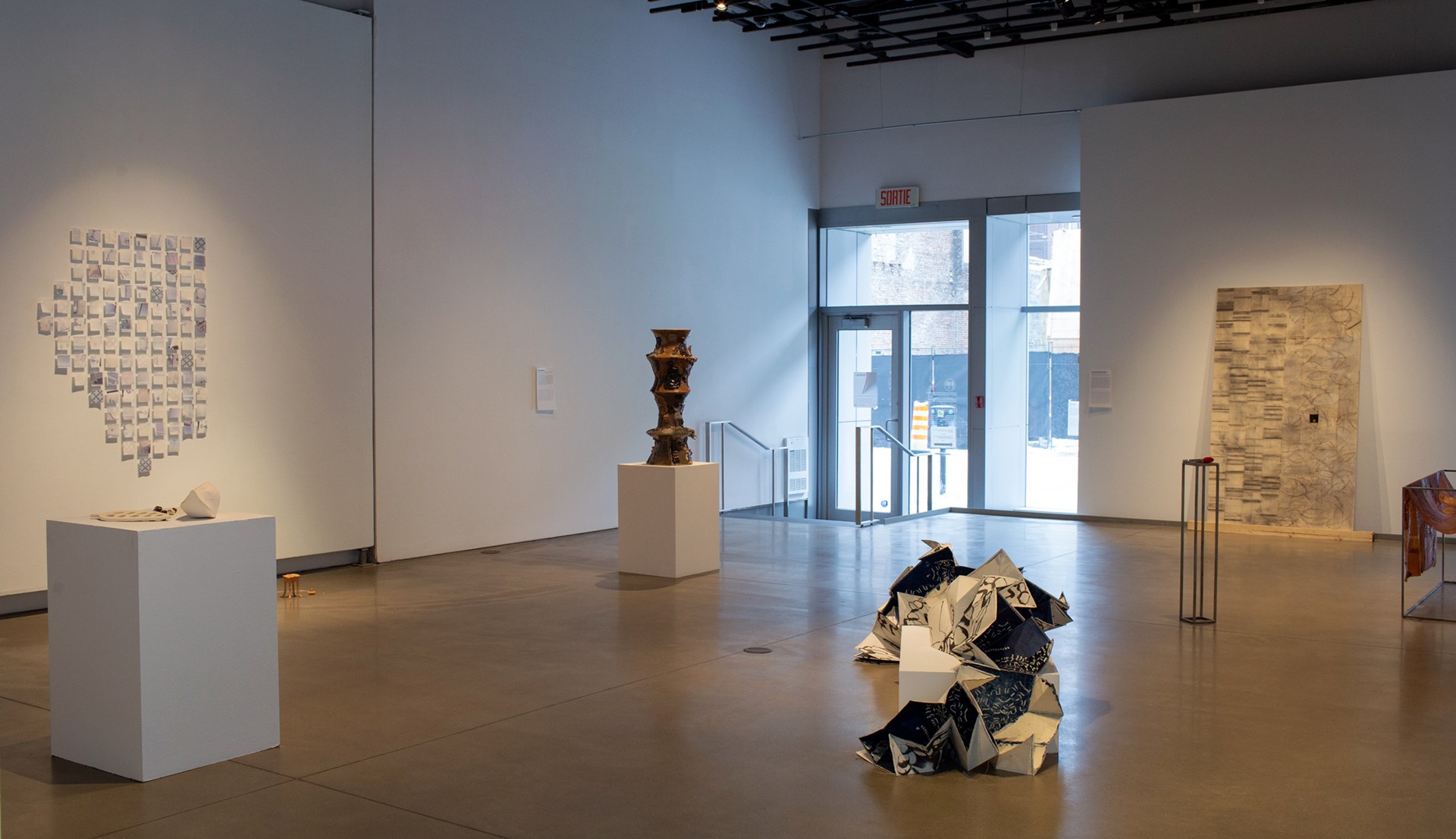 Main space documentation. From left to right: Jorge Lopera, Seeds of Hope, Clara-Jane Rioux Ficet, vestiges de nos déshabillements, Cassi Camille, Self-preservation, an act of political warfare, Catherine Desroches, déliaison du corps contre le ciel, Lucy Gill, Mastication.
Main space documentation. From left to right: Jorge Lopera, Seeds of Hope, Clara-Jane Rioux Ficet, vestiges de nos déshabillements, Cassi Camille, Self-preservation, an act of political warfare, Catherine Desroches, déliaison du corps contre le ciel, Lucy Gill, Mastication.
Many of the exhibited artworks propose visceral explorations of the body-as-space and space-as-body; more crucially, making records of the rhythm to which pulse and spatial containment become a fatal synchrony. If last year’s exhibition An Anatomy of Apocalyptic Care (2023), invited a reconsideration of objecthood and bodily sensibility from a hopeful standpoint of apocalyptic reflection, this year's exhibition advances the anatomic inquiry (the structural mapping of biological systems) past the compromised integrity of the body: disembodiment, cannibalism, ecdysis, outgrowings, abstract patterning, sublimation, and metamorphosis are recurrent transiencies enacted by the artworks.
In a down-swirl world where all movements now seem dismal, stepping back to examine our trajectories, imprints, and directions, peering down at the pierced Earth is like looking at a map of voids; and yet, here lies the cartographic potential of this exhibition, in which the selected artworks allow us to trace between them conceptual routes of escape. Movements out of emergency.
[Escape]
But remember what they say,
The last dance
You dance alone.
Note:
The question on art and emergency has by principle the same anthropomorphic animism from which most cosmovisions idealize that all things move towards a something on behalf of their own reason. This notion of motion-towards-reason is indeed what lies at the base of art’s privileged presumption to be the material embodiment of humankind’s finest intellect in-movement, always following sensible causes and reaching for the new. Of course, all art is frantic emergence of unreasonable movement and desire, yet, in our late-capitalist milieu, both, the role of art, and (in relation to) the phenomenology of movement have been brought into question as to what sort of motion has adhered us to a system of unreasonable and predatory automation of objects, bodies, and their affects; driven out from direction and into accelerated streamflows of abstracted value, produced above all feasible and sustainable, and with no plausible end other than exhaustion—motorized world dysmorphia. Resistant reimaginations such as those provoked in this exhibition’s collection of works, spawn almost pathologically, retracing back to primitive reflections on rhythm and retrieving its qualities of metaphysical organization. The question of rhythm is so important to our contemporary condition, in part, because it allows us to recognize a fragmented synchrony of our world experience. In doing so, it poses a challenge to our anthropomorphic conception of reasonable movement; and this is where art, acting on behalf of the collected objects and events of this exhibition, begins to move again.
Less as a reflection and more as a mirage looking to post-bodied unbearable reformation. Recurrent body-imploding transiencies enacted by the artworks: disembodiment, cannibalism, ecdysis, outgrowings, abstract patterning, sublimation, metamorphosis.
In a down-swirl world where all movements now seem dismal, stepping back to look at our trajectories, imprints, and directions, looking down at the pierced Earth is like looking at a map of voids; yet, here lies the cartographic potential of this exhibition, in which the selected artworks allow us to trace between them conceptual routes of escape. Movements out of emergency.
[i] Jorge Lopera in conversation with the author, January 2024.
About the author
Emiliano is a writer and aspiring researcher working at the crossroads of critical imagination and radical aesthetic experience. His writing draws inspiration from the literary, philosophical, and conceptual detours made possible by the experimental analysis of works of art, narratives, or any object of thought charged with severed creative implications. Emiliano is an undergraduate student at Concordia University, soon to complete his BA in Communication and Cultural Studies. He is also a research candidate at the New Centre of Research and Practice's Transdisciplinary Studies program. His editorial contributions include TUNICA Magazine, Concordia's Undergraduate Journal of Art History, and now the FOFA Gallery.

